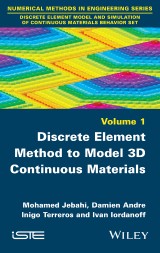Details

Discrete Element Method to Model 3D Continuous Materials
1. Aufl.
|
139,99 € |
|
| Verlag: | Wiley |
| Format: | |
| Veröffentl.: | 26.02.2015 |
| ISBN/EAN: | 9781119102915 |
| Sprache: | englisch |
| Anzahl Seiten: | 196 |
DRM-geschütztes eBook, Sie benötigen z.B. Adobe Digital Editions und eine Adobe ID zum Lesen.
Beschreibungen
<p>Complex behavior models (plasticity, cracks, visco elascticity) face some theoretical difficulties for the determination of the behavior law at the continuous scale. When homogenization fails to give the right behavior law, a solution is to simulate the material at a meso scale in order to simulate directly a set of discrete properties that are responsible of the macroscopic behavior. The discrete element model has been developed for granular material. The proposed set shows how this method is capable to solve the problem of complex behavior that are linked to discrete meso scale effects. </p>
<p>LIST OF FIGURES ix</p> <p>LIST OF TABLES xv</p> <p>PREFACE xvii</p> <p>INTRODUCTION xxi</p> <p><b>CHAPTER 1. STATE OF THE ART: DISCRETE ELEMENT MODELING 1</b></p> <p>1.1. Introduction 1</p> <p>1.2. Classification of discrete methods 3</p> <p>1.2.1. Quantum mechanical methods 4</p> <p>1.2.2. Atomistic methods 5</p> <p>1.2.3. Mesoscopic discrete methods 8</p> <p>1.3. Discrete element method for continuous materials 16</p> <p>1.4. Discrete-continuum transition: macroscopic variables 17</p> <p>1.4.1. Stress tensor for discrete systems 18</p> <p>1.4.2. Strain tensor for discrete systems 21</p> <p>1.5. Conclusion 31</p> <p><b>CHAPTER 2. DISCRETE ELEMENT MODELING OF MECHANICAL BEHAVIOR OF CONTINUOUS MATERIALS 33</b></p> <p>2.1. Introduction 33</p> <p>2.2. Explicit dynamic algorithm 35</p> <p>2.3. Construction of the discrete domain 37</p> <p>2.3.1. The cooker compaction algorithm 39</p> <p>2.3.2. Geometrical characterization of the discrete domain 44</p> <p>2.4. Mechanical behavior modeling 56</p> <p>2.4.1. Cohesive beam model 58</p> <p>2.4.2. Calibration of the cohesive beam static parameters 64</p> <p>2.4.3. Calibration of the cohesive beam dynamic parameters 79</p> <p>2.5. Conclusion 87</p> <p><b>CHAPTER 3. DISCRETE ELEMENT MODELING OF THERMAL BEHAVIOR OF CONTINUOUS MATERIALS 93</b></p> <p>3.1. Introduction 93</p> <p>3.2. General description of the method 95</p> <p>3.2.1. Characterization of field variable variation in discrete domain 95</p> <p>3.2.2. Application to heat conduction 96</p> <p>3.3. Thermal conduction in 3D ordered discrete domains 97</p> <p>3.4. Thermal conduction in 3D disordered discrete domains 100</p> <p>3.4.1. Determination of local parameters for each discrete element 102</p> <p>3.4.2. Calculation of discrete element transmission surface 103</p> <p>3.4.3. Calculation of local volume fraction 104</p> <p>3.4.4. Interactions between each discrete element and its neighbors 105</p> <p>3.5. Validation 106</p> <p>3.5.1. Cylindrical beam in contact with a hot plane 106</p> <p>3.5.2. Dynamically heated sheet 107</p> <p>3.6. Conclusion 113</p> <p><b>CHAPTER 4. DISCRETE ELEMENT MODELING OF BRITTLE FRACTURE 115</b></p> <p>4.1. Introduction 115</p> <p>4.2. Fracture model based on the cohesive beam bonds 118</p> <p>4.2.1. Fracture criterion 118</p> <p>4.2.2. Calibration 120</p> <p>4.2.3. Convergence study 123</p> <p>4.2.4. Validation 125</p> <p>4.3. Fracture model based on the virial stress 132</p> <p>4.3.1. Fracture criterion 132</p> <p>4.3.2. Calibration 134</p> <p>4.3.3. Convergence study 134</p> <p>4.3.4. Validation 136</p> <p>4.4. Conclusion 137</p> <p>CONCLUSION 141</p> <p>BIBLIOGRAPHY 145</p> <p>INDEX 161</p>
<p><strong>Mohamed Jebahi</strong>, Université de Laval, Canada. <p><strong>Damien Andre</strong>, Arts et Métiers ParisTech, I2M, France. <p><strong>Inigo Terreros</strong>, Arts?et Métiers ParisTech, France. <p><strong>Ivan Iordanoff</strong>, Professor at Arts et Métiers ParisTech, Research at I2M laboratory, France.
Diese Produkte könnten Sie auch interessieren:

Turbulent Drag Reduction by Surfactant Additives

von: Feng-Chen Li, Bo Yu, Jin-Jia Wei, Yasuo Kawaguchi

156,99 €

Turbulent Drag Reduction by Surfactant Additives

von: Feng-Chen Li, Bo Yu, Jin-Jia Wei, Yasuo Kawaguchi

156,99 €














